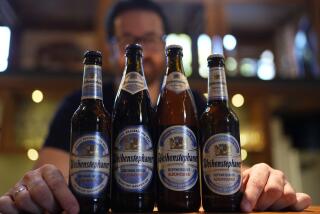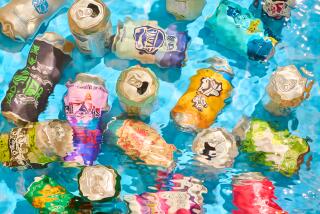Made for hot coals and summer days
- Share via
ON a hot summer afternoon of baseball or a warm evening of barbecuing, just about any beer can start to look pretty good. One species, however, suits those overheated moments perfectly, though it’s still relatively little known in this country.
Wheat beers -- foamy, cloudy and so delicate, with their hints of spice and fruit, that they’re sometimes referred to as breakfast beers -- may be the ultimate thirst-quenching accompaniment to a wide range of summery foods, especially anything spicy or grilled.
The brew is called hefeweizen (in German, hefe means yeast and weizen means wheat). In recent years, it has gained new popularity in America, primarily because it offers the visual cachet of a craft brew (and some actual flavor), without overly challenging the palates of Coors Light and Bud drinkers. Any decent Southern California tavern is likely to have at least one hefeweizen on tap. (Ask for “HAY-feh-vye-tsen,” to be rigorously Teutonic about it, although “HEFF-a-wisen” usually brings the desired result locally.)
The term loosely refers to any beer brewed from wheat and barley -- a typical formula is 50% of each rather than from barley alone. Wheat imparts a bready delicateness and a dry, citrusy quality to a brew.
Hefeweizen has its roots in Bavaria, where special strains of yeast produce a spritzy brew with characteristic aromas and flavors of cloves and bananas. The beers are nearly free of hops and thus have little or no bitterness. Partial fermentation in the bottle imparts a signature cloudiness from suspended yeast particles and wheat proteins. Wheat beers from that region are the hefeweizens still most prized by connoisseurs.
In Belgium, a different sort of wheat beer, known as wit bier (“white beer”) evolved. It parts ways with the Bavarian product in that it typically is brewed with bitter orange peel and ground coriander seeds, which add a pronounced fruity tang and an earthy spiciness. The Belgian style, which is imitated by some American craft brewers, generally is not called hefeweizen.
In the United States, a third style was given birth in 1986 by Widmer Brothers Brewing Co. of Portland, Ore. Widmer’s Hefeweizen is densely cloudy, light and crisp, less carbonated and considerably more bitter and ale-like than the Bavarian beers. Because it doesn’t employ the traditional Bavarian yeasts, Widmer’s is devoid of the clove-and-banana aspects that define the German product.
Widmer Brothers was a reluctant parent of its hefe. The brewery initially produced two beers, one of which was a clear, filtered wheat ale. When a Portland pub owner asked for a third Widmer’s beer for its taps, the brewery uneasily offered wheat beer that had not yet been filtered.
“Our yeast likes to stay in suspension, and we were a little wary,” says brewery co-founder Kurt Widmer. “People drink a lot with their eyes, and we were afraid people would say, ‘Oh, my God, what is this? Your beer is really cloudy.’ We didn’t want to be mistaken for home brewers or something. We thought of even not putting our name on it.”
A modern wave
Today, Widmer Brothers Hefeweizen, at 1.5 million cases a year, is the largest-selling wheat beer in the United States. Some American producers, however, cleave to the classic Bavarian style (a good example, available in bottles, is Portland Brewing Co.’s Uncle Otto’s Weiss Beer). Those brewers, however, must swim against the current unleashed by Widmer’s.
“It’s a little frustrating,” says Mark Jilg, proprietor of Pasadena’s Craftsman Brewing Co. and maker of an award-winning, Bavarian-style hefe that’s available only on draft. “People drink an American-style wheat ale and they’ve been told it’s hefeweizen, and it’s clearly not. If you look for the clovey and banana-y aspect, it’s completely missing.”
Regardless of its source, hefeweizen ideally carries a super charge of carbonation, like Champagne. It should be poured into a tall glass to produce a great, pillowy head that explodes the beer’s aromas and flavors. Drinking it straight from the bottle is, as with any worthwhile beer, a terrible idea.
There’s another reason for giving hefeweizen a good pour. The yeast, which is crucial to its taste, tends to accumulate in the bottom of the bottle and will be lost to all but the most intrepid bottle-sippers.
“When you pour a hefe, pour about three-quarters of the bottle in a tilted glass, then swirl or shake up that yeast in the bottom, and dump it in the glass,” says beer expert and author Stephen Beaumont. “It adds to the flavor and it’s also good for you. Yeast is very rich in vitamins.” A diligent establishment that offers hefeweizen on draft will agitate a keg before tapping it to evenly distribute the yeast through the beer.
Then there is the whole matter of lemon.
For some reason, in most American establishments hefeweizen has come to be served with a wedge of lemon, possibly because it gives the beer a unique look. Corona, after all, is served with lime. Connoisseurs, however, avoid lemon.
“The oil in lemon peel will pretty much kill the head on pretty much any beer,” says Jilg. “It adds an aromatic quality that’s completely foreign to this particular beer. If you have a good, fresh, German-style hefeweizen, it’s hard to imagine adding anything to it, it’s such a satisfying experience in itself.”
Widmer’s promotional imagery depicts its hefeweizen served with lemon, but even Kurt Widmer prefers letting consumers decide. “We like it served with lemon on the glass rather than in it, so that the drinker has a choice. About 80% of them will take it off the glass and squeeze it in. Some just take it away -- and I’m one of them.”
Short shelf life
Wheat beers are particularly vulnerable to time. Their relatively low alcohol content (4% to 5% by volume) provides little preservative protection. Their pronounced yeastiness eventually becomes a drawback, as yeasts with no sugars left to feed on turn on one another and wreck the beers’ delicate flavors.
In a recent sampling of 18 wheat beers available in Los Angeles-area stores, almost a third had been on the shelf too long, some for as long as a year, and were “off” in aroma and/or taste.
Many wheat beers are brewed for summer, and the newest batches of them have just begun reaching retailers. Any hefeweizen that’s more than 4 or 5 months old ought to be considered suspect (Belgian-style wheat beers remain stable somewhat longer). Some of the beers include on their labels the dates they were brewed or the dates by which they should be withdrawn from sale. Many, unfortunately, do not, and in those cases a consumer shouldn’t be shy about asking a retailer how long a given beer has been in the store.
“Almost any beer is at its optimum within 120 days of leaving the brewery, assuming it’s been kept at the proper cool temperature,” says Jilg. “That’s especially the case with wheat beers, because they’re all about freshness.”
*
(BEGIN TEXT OF INFOBOX)
THE BEST BOTTLES
There are three main styles of hefeweizens: American, traditional Bavarian and Belgian wit bier. Some brands, such as Widmer Brothers and Pyramid Wheat Ale, are reliably found in supermarkets. Others must be hunted down at specialty sources such as Whole Foods Market, Hi-Time Wine Cellars in Costa Mesa, the Wine House in West L.A. and John & Pete’s Liquor in West Hollywood. Prices range from $7 to $9 for a six-pack and $2.50 to $3.50 for a 22-ounce bottle. Regardless of style, freshness is an important consideration. Of 20 beers collected for this tasting, six, including well-known products from Samuel Adams and the Bavarian producer Weihenstephan, were eliminated because they had been too long on the shelf and had taken on a burnt-rubber aroma and flat, dull taste.
Style: Characteristics: Recommended brands:
Style: American
Characteristics: Pale and light-bodied, with noticeable hops bitterness
Recommended brands:
Widmer Brothers Hefeweizen (Ore.)
Pyramid Hefeweizen Ale (Calif.)
Sierra Nevada Wheat Beer (Calif.)
Blue Star Wheat Beer (Calif.)
Bert Grant’s HefeWeizen (Wash.)
*
Style: Bavarian
Characteristics: Delicate, non-bitter, with distinct aroma and flavor of bananas and cloves
Recommended brands:
Franziskaner Hefe-Weisse (Bavaria)
Edelweiss Hefetrub (Austria)
Schneider Weisse (Bavaria)
Uncle Otto’s Weiss Beer (Ore. )
Hopf Helle Weisse (Bavaria)
Ayinger Brau-Weisse (Bavaria)
Paulaner Hefe-Weizen (Bavaria)
*
Style: Belgian
Characteristics: Light, tangy and earthy, with flavors of citrus and coriander Wittekerke Wheat Ale (Belgium)
Recommended brands:
Great White Beer (Calif.)


